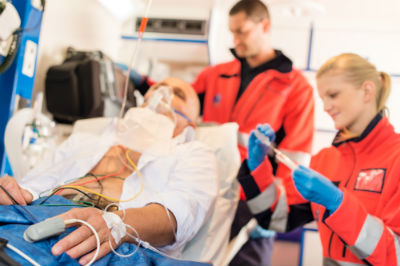EMT Training is often the first step to becoming a Paramedic. Indeed EMT Training can form the basis for many advanced medical and emergency services careers such as doctor, nurse, and firefighter.
Take the first step today and reach out to some schools offering EMT training in your area. At Healthcare Graduate we specialize in matching those interested in a career as an EMT or Paramedic with the best EMT Classes and Schools available in their area. We will guide you through what you need to know to become an EMT and how to select the best training and schools for you.
- What does an EMT do?
- How much do EMT’s make?
- What’s the difference between EMT and Paramedic?
- How to become an EMT?
- EMT to Paramedic?
- What are the best EMT classes near me?
| Key Facts | Detail |
|---|---|
| Educational Requirements | Most States will require you to complete an EMT basic training program as well as pass either a State or National certification exam |
| Average Annual Salary | $35,430 |
| Average Salary Range | $20,860 to $77,770 (depending on experience and location) |
| Number in Employment (2016) | 242,000 |
| Employment Outlook | Excellent |
| Work Environments | Hospitals, Private Ambulance Service, Charity Sector |
| Related Careers | Medical Assistants, CNA, Physician Assistant |
What is an EMT?
 Emergency Medical Technicians are healthcare providers who are responsible for initially assessing the condition of a patient and determining the necessary course of action. They handle casualties arising in the field – from emergencies such as natural disasters, air accidents, road accidents, fires, and criminal violence, etc.
Emergency Medical Technicians are healthcare providers who are responsible for initially assessing the condition of a patient and determining the necessary course of action. They handle casualties arising in the field – from emergencies such as natural disasters, air accidents, road accidents, fires, and criminal violence, etc.
The majority of EMTs work on land ambulances while they may also work on air ambulances, planes and helicopters.
Duties and responsibilities of an EMT
The job of an EMT is physically as well as emotionally demanding. They should be prepared to work weekends and odd hours during the day or night. EMTs will have to work in conjunction with firefighters, police officers, paramedics, and emergency care assistants. EMTs are usually recruited from health care facilities, fire departments, ambulance services, rescue operations, and inter-hospital transport services. An EMT has to shoulder a lot of responsibilities during an emergency situation. Hence, their job can be quite a demanding and stressful one. These professionals are at a higher risk of exposing themselves to contagious diseases and physical injuries. Their work involves bending, moving, lifting, and kneeling to rescue patients. Although the job is extremely demanding at times, it offers a mental satisfaction since an EMT helps save the lives of patients going through a critical phase.
- Provide basic life support to patients before they will be transported to the nearest hospital. The EMT may have to drive to the scene of the emergency for this purpose.
- Evaluate the patient’s condition and determine the right course of action.
- Provide medical assistance such as CPR, AED, ventilation, control bleeding, prevent spinal damage, bandaging wounds, and preventing shock. They should be prepared to do whatever is necessary to stabilize the condition of the patient.
- Check and replace the damaged and used supplies. Maintain cleanliness of the equipment.
- Transfer the patients to emergency units of the hospital.
- Administration of oxygen, oral glucose, and activated charcoal when required.
- Maintain a patient’s care report and note the medical treatments administered to them.
- Clean and sterilize the interior of the ambulance when it is used to transport a patient with a contagious disease.
- Check and replace the stocks of medicines, linen, blankets, and other supplies in the ambulance.
- Calm down the patient’s family members and help them relax.
- Attend continuing education programs and refresher training programs.
Educational Qualifications
- You should be over 18-years of age and possess a high school diploma or GED.
- Complete the required number of hours of a state-approved training program.
- Pass the certification examination and obtain the state license.
- Obtain the Cardiopulmonary Resuscitation (CPR) certification.
- Should possess a clean criminal background.
Skills And Personal Traits Required
Candidates applying for a post of EMT should possess the following skills and personal traits. They should be excellent communicators in the first place. EMTs should have good problem-solving skills and physical strength to work under rigorous conditions. They should be compassionate towards the patients. EMTs should also have good listening and interpersonal skills.
In conclusion, the role and responsibilities of an emergency medical technician may vary depending on the emergency that they handle. The aforementioned article provides a comprehensive overview of the most important roles and responsibilities of an emergency medical technician also known as EMTs.
- Administration of oxygen, oral glucose, and activated charcoal when required.
- Maintain a patient’s care report and note the medical treatments administered to them.
- Clean and sterilize the interior of the ambulance when it is used to transport a patient with a contagious disease.
- Check and replace the stocks of medicines, linen, blankets, and other supplies in the ambulance.
- Calm down the patient’s family members and help them relax.
- Attend continuing education programs and refresher training programs.
